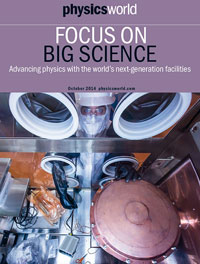By Michael Banks
This year has been a special one for the CERN particle-physics lab near Geneva as it turns 60 years old. It was back in 1954 when the CERN convention was ratified by its first 12 member states and the European Organization for Nuclear Research was officially established.
 The past few months have seen CERN celebrate in style with a whole host of symposia, meetings, plays, films, concerts and other events being held at the lab and at member states across Europe.
The past few months have seen CERN celebrate in style with a whole host of symposia, meetings, plays, films, concerts and other events being held at the lab and at member states across Europe.
Indeed, researchers at CERN have had a lot to celebrate recently, following the discovery of the Higgs boson at the lab in 2012, and they will be hoping for yet more success when the Large Hadron Collider (LHC) switches on next year following a two-year upgrade and maintenance programme.
In the latest Physics World focus issue on “big science” we look at what has been going on at CERN during the shutdown as the lab gears up to hunt new particles beyond the Higgs boson. Once back online, the LHC will be generating even more data than in its previous run and this focus issue also investigates how researchers are going to deal with the huge volumes of information that will be generated at many upcoming facilities, as well the need to train the next generation of researchers to use them.
Here is a rundown of what is in the 2014 focus issue on big science.
• CERN gears up for LHC switch-on? – Following a two-year shutdown, CERN’s Large Hadron Collider is set to hunt for particles beyond the Standard Model, as reports Ned Stafford
• Doubling up for double-beta decay – Physicists are hoping to detect a rare form of nuclear decay by filling a huge plastic sphere with an ultra-pure liquid of tellurium, as Edwin Cartlidge finds out
• Drilling down to catch cosmic rays – Jude Dineley describes how the Askaryan Radio Array in the South Pole hopes to finally pin down the origin of high-energy cosmic rays
• Supporting the next generation – Bill Stirling, director of the Institut Laue-Langevin in Grenoble, France, warns of a shortage of scientists able to use upcoming big-science facilities
• The new MKID on the block – Telescopes hunting for dark energy could be boosted by a new kind of imaging device based on superconductors, as Edwin Cartlidge explains
• Surviving the flood – Jon Cartwright looks at how future big-science facilities will have to manage the huge amounts of data produced
• Reducing cosmic rays to a trickle – A neutrino experiment is aiming to reduce stray signals from cosmic rays by growing copper a mile underground, as Michael Schirber reports
All full members of the Institute of Physics received a print edition of the focus issue along with their copy of the October issue of Physics World. You can also read the focus issue free of charge via the desktop or on any Apple device using the Physics World app, available from the App Store. (Please note that the new Android version will be available very soon.)
I hope you find this focus issue stimulating and please do let us have your comments by e-mailing pwld@iop.org or leaving your remarks below.
Trackback: Physics Viewpoint | Physics World 2014 Focus on Big Science is out now